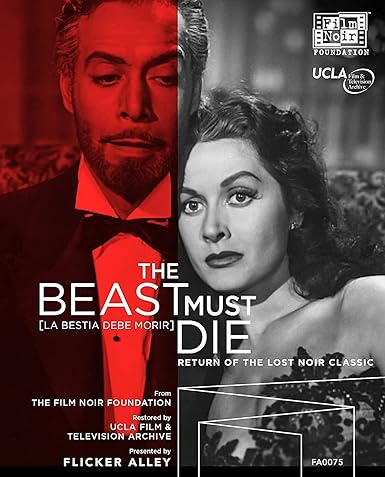A long-lost treasure of Argentine noir rediscovered! Thanks to the efforts of the Film Noir Foundation and UCLA Film & Television Archive, director Román Viñoly Barreto’s compelling 1952 thriller has been rescued and restored to its original brilliance.
Mystery writer Felix Lane, (legendary Spanish actor Narciso Ibáñez Menta), suffers a tragic loss; his nine-year-old son is killed in a hit-and-run car accident. Desperate for vengeance, Lane bypasses the authorities, adopts a new identity, and begins looking for clues that will lead him to the culprit. The suspense reaches hair-raising levels as Felix’s vendetta leads him to infiltrate an affluent family rife with its own intrigues. But who among this highly suspect bunch is the killer? And will Felix follow his mission to its bitter end? Based on Cecil Day-Lewis’ influential 1936 novel The Beast Must Die (written as Nicholas Blake), Viñoly Barreto’s film is a stunning adaptation of one of the true landmarks of crime fiction and psychological suspense.
Flicker Alley is honored to present this world-premiere Blu-ray Disc/DVD combo edition of the superb
The Beast Must Die (La Bestia Debe Morir), a heretofore virtually unknown addition to the canon of classic international noir. This landmark release, gorgeously restored, was achieved through the dedicated efforts of the Film Noir Foundation and UCLA Film and Television Archive, with special thanks to the Hollywood Foreign Press Association’s Charitable Trust.
Bonus Materials Include:
●
Introduction to The Beast Must Die (La Bestia Debe Morir) – By author, historian, and “noirchaeologist” Eddie Muller
●
Newly Recorded Conversation – Between Argentine film archivist and historian Fernando Martín Peña and Daniel Viñoly, son of visionary director Román Viñoly Barreto.
●
Profile of Actor Narciso Ibáñez Menta – By film historian Fernando Martín Peña
●
Audio Commentary Track – By author and film historian Guido Segal.
●
Souvenir Booklet – Featuring rare original photographs, posters, lobby cards, and advertisements, along with an essay by Guido Segal.

 ¡Bienvenido a mundodvd! Regístrate ahora y accede a todos los contenidos de la web. El registro es totalmente gratuito y obtendrás muchas ventajas.
¡Bienvenido a mundodvd! Regístrate ahora y accede a todos los contenidos de la web. El registro es totalmente gratuito y obtendrás muchas ventajas.


 LinkBack URL
LinkBack URL About LinkBacks
About LinkBacks




 Citar
Citar.jpg?width=1920&height=1080&fit=bounds)
